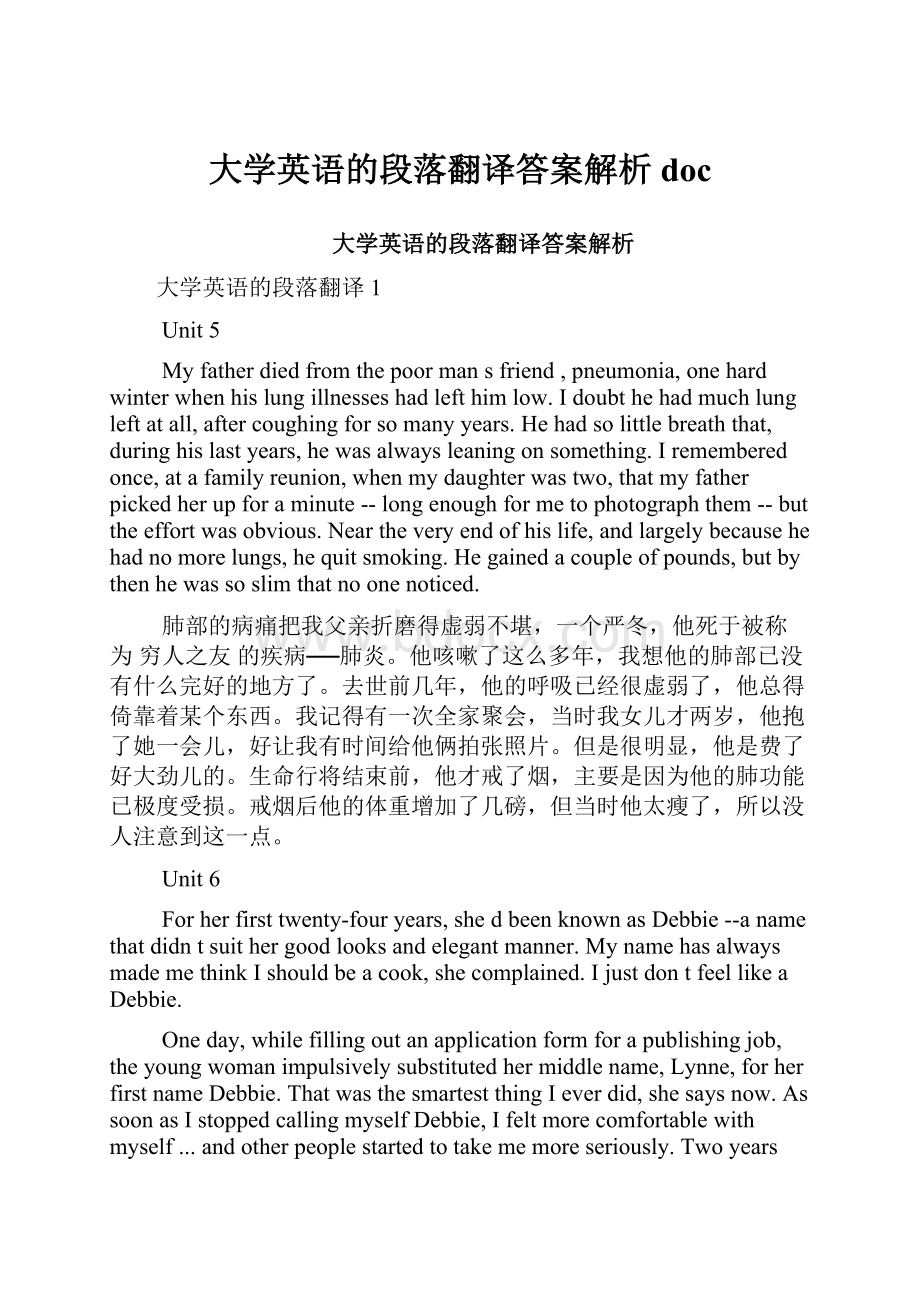大学英语的段落翻译答案解析doc.docx
《大学英语的段落翻译答案解析doc.docx》由会员分享,可在线阅读,更多相关《大学英语的段落翻译答案解析doc.docx(13页珍藏版)》请在冰豆网上搜索。

大学英语的段落翻译答案解析doc
大学英语的段落翻译答案解析
大学英语的段落翻译1
Unit5
Myfatherdiedfromthepoormansfriend,pneumonia,onehardwinterwhenhislungillnesseshadlefthimlow.Idoubthehadmuchlungleftatall,aftercoughingforsomanyyears.Hehadsolittlebreaththat,duringhislastyears,hewasalwaysleaningonsomething.Irememberedonce,atafamilyreunion,whenmydaughterwastwo,thatmyfatherpickedherupforaminute--longenoughformetophotographthem--buttheeffortwasobvious.Neartheveryendofhislife,andlargelybecausehehadnomorelungs,hequitsmoking.Hegainedacoupleofpounds,butbythenhewassoslimthatnoonenoticed.
肺部的病痛把我父亲折磨得虚弱不堪,一个严冬,他死于被称为穷人之友的疾病──肺炎。
他咳嗽了这么多年,我想他的肺部已没有什么完好的地方了。
去世前几年,他的呼吸已经很虚弱了,他总得倚靠着某个东西。
我记得有一次全家聚会,当时我女儿才两岁,他抱了她一会儿,好让我有时间给他俩拍张照片。
但是很明显,他是费了好大劲儿的。
生命行将结束前,他才戒了烟,主要是因为他的肺功能已极度受损。
戒烟后他的体重增加了几磅,但当时他太瘦了,所以没人注意到这一点。
Unit6
Forherfirsttwenty-fouryears,shedbeenknownasDebbie--anamethatdidntsuithergoodlooksandelegantmanner.MynamehasalwaysmademethinkIshouldbeacook,shecomplained.IjustdontfeellikeaDebbie.
Oneday,whilefillingoutanapplicationformforapublishingjob,theyoungwomanimpulsivelysubstitutedhermiddlename,Lynne,forherfirstnameDebbie.ThatwasthesmartestthingIeverdid,shesaysnow.AssoonasIstoppedcallingmyselfDebbie,Ifeltmorecomfortablewithmyself...andotherpeoplestartedtotakememoreseriously.Twoyearsafterhersuccessfuljobinterview,theformerwaitressisnowasuccessfulmagazineeditor.FriendsandassociatescallherLynne.
在她人生最初的24年里,人们一直叫她戴比一个和她的漂亮容貌和优雅举止不相配的名字。
我的名字总是使我觉得自己应该是一个厨子,她抱怨道,我真的不想要戴比这个名字。
一天,在填写一份出版工作职位的申请表时,这位小姐一时冲动,用她的中名林恩替了她的名字戴比。
这是我一生中干得最漂亮的一件事,现在她对人这样说,一旦我不再称自己为戴比,我就感到好多了;而且其他人也开始更认真地对待我了。
顺利地通过那次工作面试两年后,这位昔日的女服务员现在成了一位成功的杂志编辑。
朋友和同事们都叫她林恩。
Unit7
Formanypeople,therootoftheirstressisanger,andthetrickistofindoutwheretheangeriscomingfrom.Doestheangercomefromafeelingthateverythingmustbeperfect?
Eliotasks.
Thatsverycommoninprofessionalwomen.Theyfeeltheyhavetobeallthingstoallpeopleanddoitallperfectly.Theythink,Ishould,Imust,Ihaveto.Goodenoughisnevergoodenough.
Perfectionistscannotdelegate.Theygetangrythattheyhavetocarryitall,andtheyblowtheirtops.Thentheyfeelguiltyandtheystartthewholecycleoveragain.
对许多人来说,压力的根源是愤怒,而对付愤怒的诀窍是找出怒从何来。
埃利奥特问道:
这种愤怒是否来自这么一种感觉:
希望一切事物都必须完美无缺?
这在职业女性中是很常见的原因。
她们觉得要让人人感到她们无所不能,而且要把样样事情都做得完美无缺。
她们认为,我应该这样,我必须这样,我不得不这样。
追求完美永无止境。
完美主义者事必躬亲。
他们生气是因为他们不得不把什么事情都扛在自己肩上,还为之发脾气。
随后他们就感到内疚,接着他们就再把整个过程重复一遍。
大学英语的段落翻译2
Unit1
HowardGardner,aprofessorofeducationatHarvardUniversity,reflectsonavisittoChinaandgiveshisthoughtsondifferentapproachestolearninginChinaandtheWest.
哈佛大学教育学教授霍华德加德纳回忆其中国之行,阐述他对中西方不同的学习方式的看法。
Learning,Chinese-Style
HowardGardner
1Foramonthinthespringof1987,mywifeEllenandIlivedinthebustlingeasternChinesecityofNanjingwithour18-month-oldsonBenjaminwhilestudyingartseducationinChinesekindergartensandelementaryschools.ButoneofthemosttellinglessonsEllenandIgotinthedifferencebetweenChineseandAmericanideasofeducationcamenotintheclassroombutinthelobbyoftheJinlingHotelwherewestayedinNanjing.
中国式的学习风格
霍华德加德纳
1987年春,我和妻子埃伦带着我们18个月的儿子本杰明在繁忙的中国东部城市南京住了一个月,同时考察中国幼儿园和小学的艺术教育情况。
然而,我和埃伦获得的有关中美教育观念差异的最难忘的体验并非来自课堂,而是来自我们在南京期间寓居的金陵饭店的大堂。
2Thekeytoourroomwasattachedtoalargeplasticblockwiththeroomnumberonit.Whenleavingthehotel,aguestwasencouragedtoturninthekey,eitherbyhandingittoanattendantorbydroppingitthroughaslotintoabox.Becausethekeyslotwasnarrow,thekeyhadtobepositionedcarefullytofitintoit.我们的房门钥匙系在一块标有房间号的大塑料板上。
酒店鼓励客人外出时留下钥匙,可以交给服务员,也可以从一个槽口塞入钥匙箱。
由于口子狭小,你得留神将钥匙放准位置才塞得进去。
3Benjaminlovedtocarrythekeyaround,shakingitvigorously.Healsolikedtotrytoplaceitintotheslot.Becauseofhistenderageandincompleteunderstandingoftheneedtopositionthekeyjustso,hewouldusuallyfail.Benjaminwasnotbotheredintheleast.Heprobablygotasmuchpleasureoutofthesoundsthekeymadeashedidthosefewtimeswhenthekeyactuallyfounditswayintotheslot.
本杰明爱拿着钥匙走来走去,边走边用力摇晃着。
他还喜欢试着把钥匙往槽口里塞。
由于他还年幼,不太明白得把钥匙放准位置才成,因此总塞不进去。
本杰明一点也不在意。
他从钥匙声响中得到的乐趣大概跟他偶尔把钥匙成功地塞进槽口而获得的乐趣一样多。
4NowbothEllenandIwereperfectlyhappytoallowBenjamintobangthekeynearthekeyslot.Hisexploratorybehaviorseemedharmlessenough.ButIsoonobservedaninterestingphenomenon.AnyChinesestaffmembernearbywouldcomeovertowatchBenjaminand,notinghislackofinitialsuccess,attempttoassist.HeorshewouldholdontoBenjaminshandand,gentlybutfirmly,guideitdirectlytowardtheslot,repositionitasnecessary,andhelphimtoinsertit.TheteacherwouldthensmilesomewhatexpectantlyatEllenorme,asifawaitingathankyou─andonoccasionwouldfrownslightly,asifconsideringustobeneglectingourparentalduties.
我和埃伦都满不在乎,任由本杰明拿着钥匙在钥匙的槽口鼓捣。
他的探索行为似乎并无任何害处。
但我很快就观察到一个有趣的现象。
饭店里任何一个中国工作人员若在近旁,都会走过来看着本杰明,见他初试失败,便都会试图帮忙。
他们会轻轻握紧本杰明的手,直接将它引向钥匙的槽口,进行必要的重新定位,并帮他把钥匙插入槽口。
然后那位老师会有所期待地对着我和埃伦微笑,似乎等着我们说声谢谢偶尔他会微微皱眉,似乎觉得我俩没有尽到当父母的责任。
5IsoonrealizedthatthisincidentwasdirectlyrelevanttoourassignedtasksinChina:
toinvestigatethewaysofearlychildhoodeducation(especiallyinthearts),andtothrowlightonChineseattitudestowardcreativity.AndsobeforelongIbegantointroducethekey-slotanecdoteintomydiscussionswithChineseeducators.我很快意识到,这件小事与我们在中国要做的工作直接相关:
考察儿童早期教育(尤其是艺术教育)的方式,揭示中国人对创造性活动的态度。
因此,不久我就在与中国教育工作者讨论时谈起了钥匙槽口一事。
TWODIFFERENTWAYSTOLEARN
6WithafewexceptionsmyChinesecolleaguesdisplayedthesameattitudeasthestaffattheJinlingHotel.Sinceadultsknowhowtoplacethekeyinthekeyslot,whichistheultimatepurposeofapproachingtheslot,andsincethechildisneitheroldenoughnorcleverenoughtorealizethedesiredactiononhisown,whatpossiblegainisachievedbyhavinghimstruggle?
Hemaywellgetfrustratedandangry─certainlynotadesirableoutcome.Whynotshowhimwhattodo?
Hewillbehappy,hewilllearnhowtoaccomplishthetasksooner,andthenhecanproceedtomorecomplexactivities,likeopeningthedoororaskingforthekey─bothofwhichaccomplishmentscan(andshould)induecoursebemodeledforhimaswell.
两种不同的学习方式
我的中国同行,除了少数几个人外,对此事的态度与金陵饭店工作人员一样。
既然大人知道怎么把钥匙塞进槽口这是处理槽口一事的最终目的,既然孩子还很年幼,还没有灵巧到可以独自完成要做的动作,让他自己瞎折腾会有什么好处呢?
他很有可能会灰心丧气发脾气这当然不是所希望的结果。
为什么不教他怎么做呢?
他会高兴,他还能早些学会做这件事,进而去学做更复杂的事,如开门,或索要钥匙这两件事到时候同样可以(也应该)示范给他看。
7Welistenedtosuchexplanationssympatheticallyandexplainedthat,firstofall,wedidnotmuchcarewhetherBenjaminsucceededininsertingthekeyintotheslot.Hewashavingagoodtimeandwasexploring,twoactivitiesthatdidmattertous.Butthecriticalpointwasthat,intheprocess,weweretryingtoteachBenjaminthatonecansolveaproblemeffectivelybyoneself.Suchself-relianceisaprincipalvalueofchildrearinginmiddle-classAmerica.Solongasthechildisshownexactlyhowtodosomething─whetheritbeplacingakeyinakeyslot,drawingahenormakingupforamisdeed─heislesslikelytofigureouthimselfhowtoaccomplishsuchatask.And,moregenerally,heislesslikelytoviewlife─asAmericansdo─asaseriesofsituationsinwhichonehastolearntothinkforoneself,tosolveproblemsononesownandeventodiscovernewproblemsforwhichcreativesolutionsarewanted.
我俩颇为同情地听着这一番道理,解释道,首先,我们并不在意本杰明能不能把钥匙塞进钥匙的槽口。
他玩得开心,而且在探索,这两点才是我们真正看重的。
但关键在于,在这个过程中,我们试图让本杰明懂得,一个人是能够很好地自行解决问题的。
这种自力更生的精神是美国中产阶级最重要的一条育儿观。
如果我们向孩子演示该如何做某件事把钥匙塞进钥匙的槽口也好,画只鸡或是弥补某种错误行为也好那他就不太可能自行想方设法去完成这件事。
从更广泛的意义上说,他就不太可能如美国人那样将人生视为一系列的情境,在这些情境中,一个人必须学会独立思考,学会独立解决问题,进而学会发现需要创造性地加以解决的新问题。
TEACHINGBYHOLDINGHISHAND
8Inretrospect,itbecamecleartomethatthisincidentwasindeedkey─andkeyinmorethanonesense.Itpointedtoimportantdifferencesintheeducationalandartisticpracticesinourtwocountries.
把着手教
回想起来,当时我就清楚地意识到,这件事正是体现了问题的关键之所在而且不仅仅是一种意义上的关键之所在。
这件事表明了我们两国在教育和艺术实践上的重要差异。
9Whenourwell-intentionedChineseobserverscametoBenjaminsrescue,theydidnotsimplypushhishanddownclumsilyoruncertainly,asImighthavedone.Instead,theyguidedhimwithextremefacilityandgentlenessinpreciselythedesireddirection.IcametorealizethattheseChinesewerenotjustmoldingandshapingBenjaminsperformanceinanyoldmanner:
InthebestChinesetradition,theywerebazheshoujiao─teachingbyholdinghishand─somuchsothathewouldhappilycomebackformore.
那些善意的中国旁观者前来帮助本杰明时,他们不是简单地像我可能会做的那样笨拙地或是犹犹豫豫地把他的手往下推。
相反,他们极其熟练地、温和地把他引向所要到达的确切方向。
我逐渐认识到,这些中国人不是简单地以一种陈旧的方式塑造、引导本杰明的行为:
他们是在恪守中国传统,把着手教,教得本杰明自己会愉快地要求再来一次。
10Theideathatlearningshouldtakeplacebycontinualcarefulshapingandmoldingappliesequallytothearts.Watchingchildrenatworkinaclassroomsetting,wewereastonishedbytheirfacility.Childrenasyoungas5or6werepaintingflowers,fishandanimalswiththeskillandconfidenceofanadult;calligraphers9and10yearsoldwereproducingworksthatcouldhavebeendisplayedinamuseum.Inavisittothehomesoftwooftheyoungartists,welearnedfromtheirparentsthattheyworkedonperfectingtheircraftforseveralhoursaday.
学习应通过不间断的精心塑造与引导而得以实现,这一观念同样适用于艺术。
我们观看了孩子们在教室里学习艺术的情景,他们的娴熟技艺令我们惊讶。
年仅5、6岁的孩子就带着成人的那种技巧与自信在画花、画鱼和动物;9岁、10岁的小书法家写出的作品满可以在博物馆展示。
有一次去两位小艺术家的家里参观,我们从孩子的父母处得知,他们每天练习数小时以完善他们的技艺。
CREATIVITYFIRST?
11Intermsofattitudestocreativitythereseemstobeareversalofpriorities:
youngWesternersmakingtheirboldestdeparturesfirstandthengraduallymasteringthetradition;andyoungChinesebeingalmostinseparable